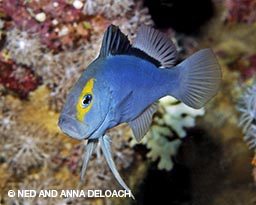Ever since our trip to the Red Sea in 2007, Anna and I had been itching to return. We finally got our chance last fall when the Reef Environmental Education Foundation (REEF) asked us to help compile an instructional package of regional fish photos. After expanding its reef fish survey project across the Caribbean, Pacific and Indian oceans during the past three decades, REEF will venture into the Red Sea in 2020. Instead of taking a liveaboard out of Hurghada, Egypt, as we did 12 years ago, our flight from Cairo set us down 70 miles north at the sprawling seaside resort of Sharm el-Sheikh. From here on the southern tip of the Sinai Peninsula, we chartered a private day boat for the week.
Besides the clear water and terrific reefs, what stuck in our memory most from the previous trip to the desert sea were two outrageous wrasse species we failed to find. The first is a multicolored brute of a fish trailing a spiked tail of eminent distinction, befittingly known as a broomtail, and the other the brilliantly colored Red Sea flasher wrasse with its oversized fins designed for seduction.

Having previously photographed many of the Red Sea’s wide-ranging cosmopolitan species in the Pacific, we planned to concentrate our efforts on endemics (species confined to a single region by geographic isolation). Sergey V. Bogorodsky and John E. Randall report that the Red Sea is home to 1,120 coastal fish species.1 Of these, 165, or roughly 15 percent, live nowhere else and have been designated as endemics. Only the remote Hawaiian archipelago and Easter Island, isolated by distance from a regular flow of larval recruits, harbor a higher percentage of homegrown species.
The origin of the Red Sea’s endemics was somewhat different, Bogorodsky and Randall explain. It began 40 million years ago when the Arabian Peninsula split away from Africa, creating a rift that formed the sea’s basin and fractured East Africa. Water from the north initially filled the sea. Much later, the northern region uplifted, cutting off the flow as the southern section subsided, allowing the waters from the Indian Ocean along with its marine life to enter through a narrow strait. During subsequent ice ages, the shallow waterway closed for extended periods, providing time for the isolated fauna to diverge from their Indian Ocean ancestors.

On our first day out on the water, we head north, skirting a rugged red coastline of wave-cut cliffs and stony beaches set against mountain peaks as bare as the desert from which they sprang. As our boat angles toward shore, a seemingly endless strand of modern, low-rise resorts forested with palms appears like a mirage. This place is the heartbeat of the fun-in-the-sun, seaside Shangri-La of European vacationers fronting one of the healthiest coral seascapes imaginable.
We slip into the water a hundred yards out from where the shallow reef shelf ends, and a wall begins plunging 50 feet to a gently sloping seafloor that disappears into infinity. Instinctively sensing not to hurry, we slowly descend, enthralled by the reef, the water and the fact we’re here. By the time I make my way to the wall an hour later, I’ve already photographed seven endemic species, including a powder-blue soapfish with yellow eye patches and a boldly patterned Red Sea anthias, and I couldn’t be happier — or so I thought.
Heading for my safety stop I catch sight of a male broomtail barreling down the wall in my direction. I can’t believe my luck. I’m after him in a blink, but he’s fast. I’m fading and close to giving up when the wrasse breaks into a glide and coasts through a cleaning station with his outrageous tail spread for grooming. I glance down at my camera’s display screen. As I squint at the image, the adage “It’s better to be lucky than good” comes to mind.

The week only gets better, except we haven’t been able to find the endemic Red Sea flasher. It’s not for lack of trying; we’ve been looking for them every morning in thick bottom cover between 60 to 80 feet, where the small plankton pickers hide from predators while waiting for the current to run.
It’s our fifth morning on the water, and we’re starting to become anxious until Anna finds three young male flashers exhibiting vestiges of the splendor displayed by the larger territorial males we’re hunting. Encouraged, we run a zigzagging search pattern along the slope. A flash of color off in the distance draws my attention. I’m off, with my eyes glued to the spot. There it is in all its glory: one of the fanciest fish in the sea courting his herd of females — providing more icing on an already sweet week of diving in the Red Sea.
Reference
1. Bogorodsky SV, Randall JE. Endemic fishes of the Red Sea. In: Rasul N, Stewart I, eds. Oceanographic and Biological Aspects of the Red Sea. Springer: Cham, Switzerland; 2019: 239–65.
© Alert Diver — Q2 2020